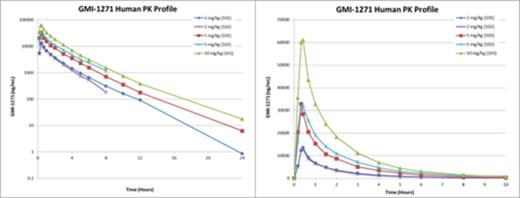Abstract

Background: GMI-1271 is a potent, specific E-selectin antagonist which targets interactions between cancer cells and the bone marrow niche thereby increasing tumor sensitivity to chemotherapy; avoids HSC mobilization; and inhibits thrombosis without increasing bleeding risk. Delayed inflammatory cell recruitment into the vein wall post thrombus induction indicates a possible decrease in leukocyte activation, which may be crucial in treating both acute and cancer associated thrombosis.
Here we report first-in-human evaluation of GMI-1271 for safety (including bleeding), PK, and biomarker data for effects on adhesion and mobilization.
Methods: Two Phase I single dose escalation DBRCT in healthy subjects evaluated 2, 5, 10, and 20 mg/kg IV doses of GMI-1271. Study 1 is complete and unblinded (GMI-1271 vs placebo). Study 2 is ongoing, remains blinded (GMI-1271 vs placebo) with open-label positive control (Lovenox), and is reported in aggregate. In both studies, assessments included safety (adverse events [AEs], clinical labs, bleeding time, PT/PTT, vitals, and exam); PK (drug levels in plasma and urine); and biomarkers (plasma soluble E-selectin [sEsel], sPsel, sICAM-1 levels; and blood CD34+ counts). Only sEsel and CD34+ are reported for Study 1; sEsel, sPsel, sICAM-1 for Study 2. Comparisons to baseline were made by ANOVA and paired t-test models; PK analyses were for total clearance (CL), volume of distribution (Vz), elimination half-life (t½), fraction excreted (Fe), and renal clearance (CLr).
Results: Forty-six subjects enrolled; 30 received GMI-1271 (10 each at 2 and 5 mg/kg; 6 at 10 mg/kg; and 4 at 20 mg/kg) and 16 received control (13 placebo, 3 Lovenox).
Safety: All subjects completed the studies; labs, vitals, and exam were unremarkable. Bleeding times and PT/PTT were unaffected by E-selectin inhibition. No serious AEs were seen. For Study 1, AEs were seen in 12/18 (66.7%) of those on GMI-1271 and 5/10 (50%) on placebo. AEs were mostly mild events at the infusion site (i.e. tenderness or erythema), and occurred in both groups. One moderate AE occurred (vasovagal reaction) in the 2 mg/kg GMI-1271 cohort. Three AEs were possibly related to drug: 2 in the 2 mg/kg cohort (infusion site bruise, lightheaded), and 1 in the 5 mg/kg cohort (metallic taste). For Study 2, AEs were seen in 12/15 (80%) of those on GMI-1271/placebo and 3/3 (100%) on Lovenox. All AEs were mild. In GMI-1271/placebo group, all AEs were considered unrelated to study drug; 3 were infusion site bruise (1 per dose level). In the Lovenox group, AEs were bruise at injection site (related) and blood in urine (possibly related).
PK: Plasma levels, Cmax, and AUC increased in a consistent dose-related manner in both studies (figure). CL, Vz, and t½ were not dose dependent; the latter averaged ~2.3 hours. ~66% of the dose was excreted unchanged in the urine independent of dose level, and CLr averaged 86 mL/min, less than estimated CrCl, suggesting tubular reabsorption is one component of CLr.
Biomarkers: In Study 1, the absolute CD34+ and %CD34+ cell counts were normal across all cohorts. There was no dose-response for changes in peripheral CD34+ counts after administration of GMI-1271 (doses 2-10 mg/kg). Plasma concentrations of sEsel were relatively constant in the placebo and GMI-1271 2 mg/kg cohorts, with significant reduction (vs baseline, p=0.012) at 48hrs post-2mg/kg dose only. In the 5 and 10 mg/kg cohorts sEsel decreased significantly post-dose (p<0.0001) and returned to baseline by 24 to 48 hours respectively; reductions were greater at high dose. In Study 2, significant reduction in sEsel was similarly seen after treatment vs baseline (p=0.05), and in sP-sel with treatment vs baseline (p = 0.04), or vs day 2 (p< 0.01). sICAM-1 was also lower after treatment vs baseline (p=0.05).
Conclusion: First-in-human experience with the potent E-selectin antagonist GMI-1271 demonstrated favorable safety and PK at single doses up to 20 mg/kg. These findings are consistent with the glycomimetic class for safety at anticipated therapeutic levels. Biomarkers of physiologic effect demonstrated clear reductions in sEsel/sPsel; decreased leukocyte adhesion with lower sICAM-1 levels; and no CD34+ rise indicating no mobilization of HSCs. Studies of GMI-1271 are ongoing to evaluate activity in hematologic malignancies and thrombosis.
Plasma concentrations and Cmax are consistent for GMI-1271 between Phase 1 studies.
Plasma concentrations and Cmax are consistent for GMI-1271 between Phase 1 studies.
Sood:Bayer: Research Funding. Hemmer:GlycoMimetics: Employment, Equity Ownership. Flanner:GlycoMimetics: Employment, Equity Ownership. Kramer:GlycoMimetics: Consultancy. Nietubicz:GlycoMimetics: Employment, Equity Ownership. Myers:GlycoMimetics: Research Funding. Wakefield:GlycoMimetics: Research Funding. Magnani:GlycoMimetics: Employment, Equity Ownership, Membership on an entity's Board of Directors or advisory committees. Thackray:GlycoMimetics: Employment, Equity Ownership.
Author notes
Asterisk with author names denotes non-ASH members.

This icon denotes a clinically relevant abstract


This feature is available to Subscribers Only
Sign In or Create an Account Close Modal